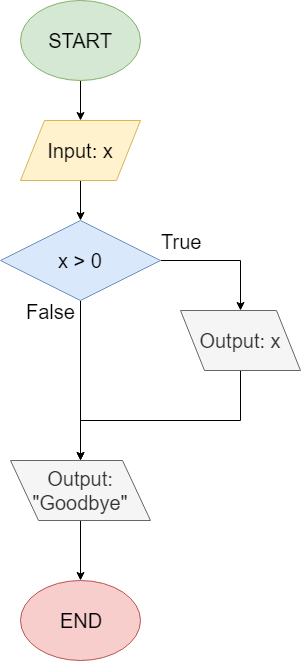If Statements
The first type of conditional construct we’ll cover is the if statement. This type of statement allows us to build a block of code which will only be executed if the given Boolean expression evaluates to true.
Here’s a simple flowchart that shows an if statement as the conditional construct:
This flowchart represents a program which will ask the user for a number as input, then print that number as output only if the number is greater than
$ 0 $. Then, the program will print Goodbye and terminate. So, if the user inputs -5, the program will only print Goodbye. However, if the user inputs 7, then the program will first print 7 followed by Goodbye. As we can see, the program will execute the section of code that prints the value of the variable if and only if the value of x > 0 is true. Otherwise, it will skip that code and continue with the rest of the program.
Notice that this statement does not include any operations in the case that x > 0 is false. Instead, the false branch points downward, and merges with the true branch after the program outputs the value of x. This is the main difference between an if statement and an if-else statement, which we’ll cover on the next page.
Most programming languages implement an if statement in a format similar to this:
<before code block>
if <Boolean expression> {
<if code block> or <True block>
}
<after code block>The program is initially executing code in the <before code block> section. Once it reaches the if keyword, it will then evaluate the <Boolean expression> to a value of either true or false. If the expression is true, then it will execute the code in the <if code block>, followed by the code in the <after code block>. If the expression is false, the program will simply continue executing code in the <after code block>, bypassing the other block entirely.
You may see the if statement referred to as the if-then statement. At the dawn of high level programming languages in 1957, one of the first languages developed was FORTRAN. FORTRAN was the first commercially available high level programming language, and it is still in use today in many scientific and mathematics heavy applications. Its syntax for this structure is
IF <condition> THEN <action>This closely follows the first order logic representation <condition> --> <action>, or condition implies action. In propositional Logic, this is read to mean “if the condition is true, it follows that the action must also be true”.
In the early 1970s, a new high level programming language named C is developed, and it comes to dominate the programming landscape by the 1990s. C remains in active development, has a huge industry code base, and greatly influenced the syntax and style of later languages. Notably, C dropped the “THEN” part of the statement, and standardized the use of curly braces to separate blocks of code:
if (condition) {
<action>
}This sets the stage for one of the enduring arcane debates in computer science – which form is “correct”. Without arguing for which is best, we have chosen the style that most resembles Java and Python syntax.
